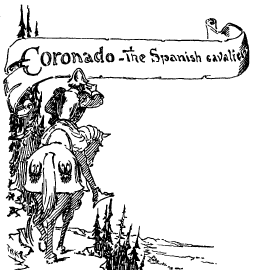|
Coronado Came to Quivira |
|
|
"Ye who love the haunts of Nature, |
|
|
|

|
|
|
16 |
|
|
|
|
myths, legends and traditions may seem to afford ground
for conjecture. All we know for a certainty is that the red
men were here when the early explorers and the Pilgrims
came, and that there are evidences in some parts of the
continent of a very ancient civilization to which long
deserted ruins and tenantless temples testify. |
|
|
|
|
17 |
|
|
Indians and from sickness caused by hardships, until only
four men survived, who for six years remained with the
tribes of Florida; then, led by one named De Vaca, they
decided to brave the perils of an unknown land and for two
years wandered among savage tribes, being the first white
men to cross the North American continent from Florida to
Mexico. |
|
|
18 |
|
|
|
|
cities, the viceroy having been instructed by Charles V.
of Spain to outfit the expedition. |
|
|
|
|
19 |
|
|
they had been told, they found Indian villages composed
of huts made of stone and mud, and the Spaniards, seeking
plunder, attacked these villages. The Indians fled at the
sight of the strange rushing figures on horseback, and as
their only weapons were arrows and stones, they soon
surrendered. Coronado was twice wounded during the fight.
There was no gold or silver of much value, but considerable
food supplies were obtained. |
|
|
20 |
|
|
|
|
prevent them from destroying his own people, who lived in
the direction they were going, and thus proved himself a
brave and patriotic man. After spending some time in
Quivira, ruled over by an Indian chief, Coronado returned to
New Mexico, October 20, 1541, arriving at Tiguex, whence he
started for Quivira, April 23, and where his army was
encamped. Tiguex was an important Indian village or pueblo,
situated on the Rio Grande river, at a point not far
southwest of Santa Fe and now in Sandoval county, New
Mexico. |
|
|
|
|
21 |
|
|
land drained by the Platte river and tributaries until
the waters began to flow into the Arkansas river. |
|

|
 |
 |
MARDOS COLLECTION
© 1999, 2000, 2001 for the NEGenWeb Project by Pam Rietsch,
T&C Miller